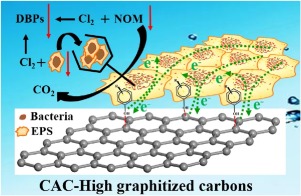当前位置:
X-MOL 学术
›
J. Hazard. Mater.
›
论文详情
Our official English website, www.x-mol.net, welcomes your feedback! (Note: you will need to create a separate account there.)
Efficient removal of disinfection by-products precursors and inhibition of bacterial detachment by strong interaction of EPS with coconut shell activated carbon in ozone/biofiltration.
Journal of Hazardous Materials ( IF 13.6 ) Pub Date : 2020-01-14 , DOI: 10.1016/j.jhazmat.2020.122077 Xueci Xing 1 , Tong Li 1 , Zhihao Bi 1 , Peng Qi 1 , Zesong Li 1 , Haibo Wang 2 , Lai Lyu 1 , Yaowen Gao 1 , Chun Hu 3
Journal of Hazardous Materials ( IF 13.6 ) Pub Date : 2020-01-14 , DOI: 10.1016/j.jhazmat.2020.122077 Xueci Xing 1 , Tong Li 1 , Zhihao Bi 1 , Peng Qi 1 , Zesong Li 1 , Haibo Wang 2 , Lai Lyu 1 , Yaowen Gao 1 , Chun Hu 3
Affiliation

|
The change of water quality was investigated in pilot-scale ozone-biological activated carbon (O3-BAC) filters using an emerging coconut shell-based granular activated carbon (CAC) or traditional granular activated carbon (GAC), respectively. More dissolved organic carbon (DOC) and disinfection by-products (DBPs) precursors were removed, meanwhile, less microbes, less metabolites and smaller microbial clusters were detected in the effluent of CAC compared with GAC. Sequentially, lower DBPs formation and higher disinfection efficiency were achieved in drinking water distribution systems (DWDSs). Furthermore, it was observed that extracellular electron transfer was enhanced in the attached biofilms of CAC, hence improving the microbial metabolic activity and biological removal of DOC. The results were attributed to the strong interaction of extracellular polymeric substances (EPS) with highly graphitized CAC. In addition, CAC resulted in totally different EPS in attached biofilms with superior characteristics including stronger viscosity, higher flocculating efficiency, mechanical stability and numerous binding sites for bacterial cells. Consequently, a wide range of compact interconnected biofilms formed on the surface of CAC and exhibited certain binding effect for microbial flocs and metabolites. Therefore, CAC resulted in higher microbial metabolic activity and lower release of microbes and metabolites, which was beneficial to maintain water quality safety in downstream DWDSs.
中文翻译:

通过在臭氧/生物过滤中EPS与椰子壳活性炭的强相互作用,可以有效去除消毒副产物前体并抑制细菌分离。
在中试规模的臭氧生物活性炭(O3-BAC)过滤器中,分别使用新兴的基于椰子壳的颗粒状活性炭(CAC)或传统的颗粒状活性炭(GAC)对水质的变化进行了研究。与GAC相比,去除了更多的溶解有机碳(DOC)和消毒副产物(DBP)前体,同时,在CAC的出水中检测到更少的微生物,更少的代谢物和更小的微生物簇。因此,在饮用水分配系统(DWDS)中,DBP的形成减少,消毒效率更高。此外,观察到在附着的CAC生物膜中细胞外电子转移增强,因此改善了微生物的代谢活性和DOC的生物去除。结果归因于细胞外聚合物(EPS)与高度石墨化的CAC的强相互作用。此外,CAC在附着的生物膜中产生了完全不同的EPS,具有优异的特性,包括更强的粘度,更高的絮凝效率,机械稳定性以及细菌细胞的许多结合位点。因此,各种各样的紧密互连的生物膜形成在CAC的表面上,并表现出对微生物絮凝物和代谢产物的一定结合作用。因此,CAC导致较高的微生物代谢活性和较低的微生物和代谢产物释放,这有利于维持下游DWDS中的水质安全。CAC在附着的生物膜中产生了完全不同的EPS,具有优异的特性,包括更强的粘度,更高的絮凝效率,机械稳定性以及众多细菌细胞结合位点。因此,各种各样的紧密互连的生物膜形成在CAC的表面上,并表现出对微生物絮凝物和代谢产物的一定结合作用。因此,CAC导致较高的微生物代谢活性和较低的微生物和代谢产物释放,这有利于维持下游DWDS中的水质安全。CAC在附着的生物膜中产生了完全不同的EPS,具有优异的特性,包括更强的粘度,更高的絮凝效率,机械稳定性以及众多细菌细胞结合位点。因此,各种各样的紧密互连的生物膜形成在CAC的表面上,并表现出对微生物絮凝物和代谢产物的一定结合作用。因此,CAC导致较高的微生物代谢活性和较低的微生物和代谢产物释放,这有利于维持下游DWDS中的水质安全。在CAC的表面上形成了许多紧密的相互连接的生物膜,并且对微生物絮凝物和代谢物表现出一定的结合作用。因此,CAC导致较高的微生物代谢活性和较低的微生物和代谢产物释放,这有利于维持下游DWDS中的水质安全。在CAC的表面上形成了许多紧密的相互连接的生物膜,并且对微生物絮凝物和代谢物表现出一定的结合作用。因此,CAC导致较高的微生物代谢活性和较低的微生物和代谢产物释放,这有利于维持下游DWDS中的水质安全。
更新日期:2020-01-14
中文翻译:

通过在臭氧/生物过滤中EPS与椰子壳活性炭的强相互作用,可以有效去除消毒副产物前体并抑制细菌分离。
在中试规模的臭氧生物活性炭(O3-BAC)过滤器中,分别使用新兴的基于椰子壳的颗粒状活性炭(CAC)或传统的颗粒状活性炭(GAC)对水质的变化进行了研究。与GAC相比,去除了更多的溶解有机碳(DOC)和消毒副产物(DBP)前体,同时,在CAC的出水中检测到更少的微生物,更少的代谢物和更小的微生物簇。因此,在饮用水分配系统(DWDS)中,DBP的形成减少,消毒效率更高。此外,观察到在附着的CAC生物膜中细胞外电子转移增强,因此改善了微生物的代谢活性和DOC的生物去除。结果归因于细胞外聚合物(EPS)与高度石墨化的CAC的强相互作用。此外,CAC在附着的生物膜中产生了完全不同的EPS,具有优异的特性,包括更强的粘度,更高的絮凝效率,机械稳定性以及细菌细胞的许多结合位点。因此,各种各样的紧密互连的生物膜形成在CAC的表面上,并表现出对微生物絮凝物和代谢产物的一定结合作用。因此,CAC导致较高的微生物代谢活性和较低的微生物和代谢产物释放,这有利于维持下游DWDS中的水质安全。CAC在附着的生物膜中产生了完全不同的EPS,具有优异的特性,包括更强的粘度,更高的絮凝效率,机械稳定性以及众多细菌细胞结合位点。因此,各种各样的紧密互连的生物膜形成在CAC的表面上,并表现出对微生物絮凝物和代谢产物的一定结合作用。因此,CAC导致较高的微生物代谢活性和较低的微生物和代谢产物释放,这有利于维持下游DWDS中的水质安全。CAC在附着的生物膜中产生了完全不同的EPS,具有优异的特性,包括更强的粘度,更高的絮凝效率,机械稳定性以及众多细菌细胞结合位点。因此,各种各样的紧密互连的生物膜形成在CAC的表面上,并表现出对微生物絮凝物和代谢产物的一定结合作用。因此,CAC导致较高的微生物代谢活性和较低的微生物和代谢产物释放,这有利于维持下游DWDS中的水质安全。在CAC的表面上形成了许多紧密的相互连接的生物膜,并且对微生物絮凝物和代谢物表现出一定的结合作用。因此,CAC导致较高的微生物代谢活性和较低的微生物和代谢产物释放,这有利于维持下游DWDS中的水质安全。在CAC的表面上形成了许多紧密的相互连接的生物膜,并且对微生物絮凝物和代谢物表现出一定的结合作用。因此,CAC导致较高的微生物代谢活性和较低的微生物和代谢产物释放,这有利于维持下游DWDS中的水质安全。


























 京公网安备 11010802027423号
京公网安备 11010802027423号